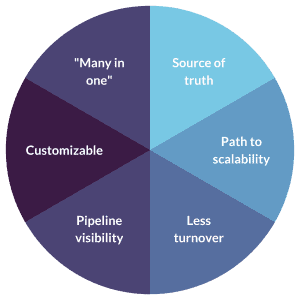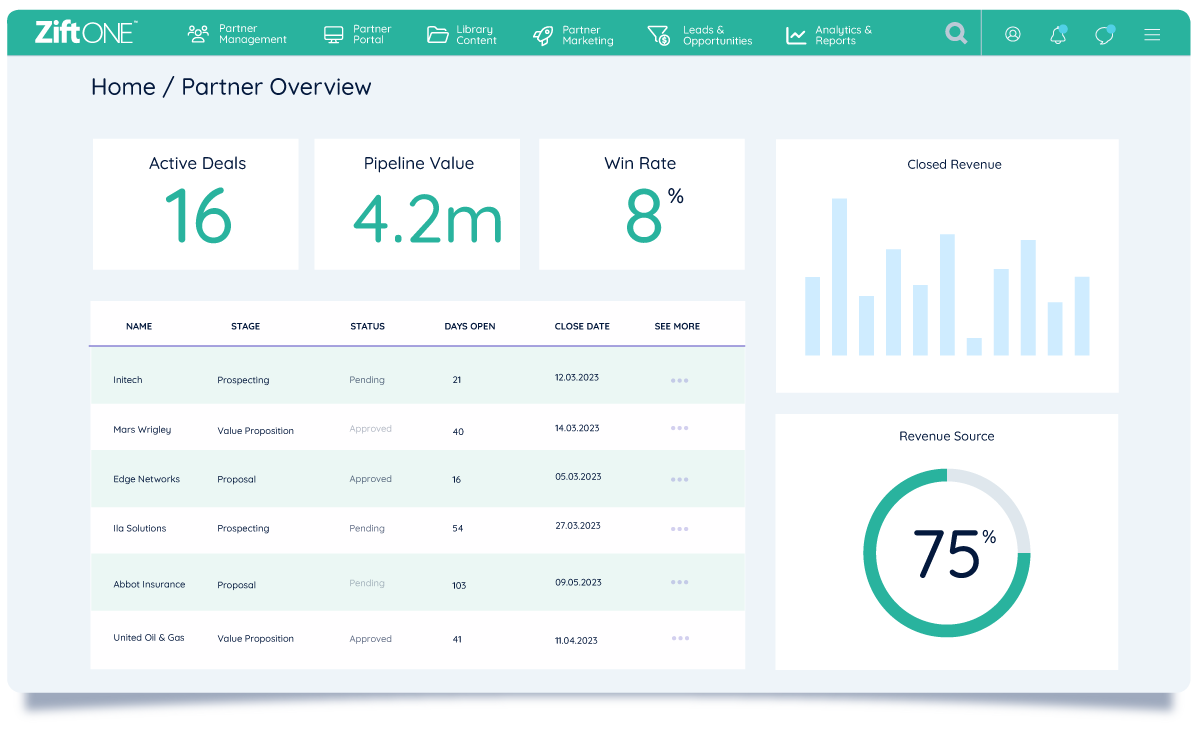
Partner programs should consider using a PRM software platform to support their partner program for these key reasons:
- A PRM Platform is a Single Source of Truth
- A PRM Platform is the Path to Partner Program Scalability
- PRM Software Protects Your Partner Program from Staff Turnover
- PRM Software is Customizable to Fit Your Partner Program Model
- Your CRM Software Can’t Take the Place of a PRM Platform
- A PRM Platform Provides Indirect Sales Pipeline Visibility and More
1. A PRM Platform is a Single Source of Truth
A high-quality PRM is a foundation on which vendors can build their programs. Providers can use the PRM as the one-stop shop for partners to engage and do business, including:
- Deal registration
- Account management
- Training
- Collateral
- Demand-gen campaigns
- MDF
- Centralizing KPIs, partner data and administrative functions on a dashboard
- Enabling deal registration for partners to claim leads
- Processing and fulfilling orders
- Analyzing financial performance, such as detailed pricing and sales data
- Integrating with customer relationship management (CRM) software and popular third-party applications
PRM software streamlines and strengthens partner program business processes to deliver mutual sales growth for providers and their indirect selling partners by:
- Organizing and orchestrating data
- Storing and sharing assets
- Tracking indirect sales transactions
- Qualifying indirect sales partners for program incentives and promotions
- Facilitating ordering and provisioning of provider solutions to partner-sourced end customers
The best PRM software offers utility and convenience vital to partner engagement. Suppliers strive to be easy to do business with, so it’s imperative that they aggregate systems, tools and platforms into a single location, so partners don’t need to remember multiple URLs and logins.

The impact of the PRM extends beyond the partner program and represents your entire company to partners. The PRM effectively provides a baseline understanding to partners of how your program, products and company work. In the same way your website is the face of your business to end customers, your PRM is the face of your program to partners.
Not having a PRM is a competitive disadvantage in today’s marketplace. If you’ve not invested in a PRM, you risk looking “small,” especially if market-leading competitors have had them for several years. Appearing “small” and under-resourced brings up a host of uncomfortable questions from partners about your capacity to serve customers, the size of your staff, your geographical reach, the reality of your 24/7/365 support commitment and how you’re reliably tracking partner deals if no partner management system is in place.
2. A PRM Platform is the Path to Partner Program Scalability
Scaling a partner program in a post-Covid economic environment requires online and digitally focused methods for partners to engage with your program; PRM software makes scalability a reality.

With the rise of remote work and flexible work schedules, partners will require tools, like a self-service PRM, that fit their plans and priorities. As partners get busier and sign with more suppliers, they need the freedom to self-serve requests instantly. Partners want to access training, create marketing campaigns or co-branded collateral, and even see and manage their pipeline and booking reports at their own pace and schedule.
Competing in a digital-first selling environment is a crucial driver of PRM software use for partners. Marketing and demand-gen tools are in high demand and partners are turning to suppliers’ PRMs to execute campaigns.
Scalability is critical for partner programs, especially for partners selling volume-based services. Most partner programs aim to scale and recruit many partners to keep the pipeline full. There are some exceptions depending on vendor business models and target accounts, but generally, it’s a numbers game, especially since not all partners will be productive. You can’t scale at a reasonable pace to service hundreds or potentially thousands of partners without a PRM software platform to automate program processes for you.
3. PRM Software Protects Your Partner Program from Staff Turnover
The channel is rife with constant personnel turnover, especially with channel account managers switching companies every 18 months. While you want to replace these front-line positions as quickly as possible, short-term vacancies won’t make or break your program if you have a high-quality PRM platform. PRMs enable partners to get core sales process components, like quoting, without needing to engage a supplier employee.
4. PRM Software is Customizable to Fit Your Partner Program Model
Partner programs have various business models for all types of partners, some of which include:
- Affiliate Partners – Affiliate partners have cultivated access to an audience uniquely invested in a specific topic and follow them to understand and keep up to date with that subject. Alliance partners typically will earn commissions.
- Referral Partners – Referral partners typically send a prospective customer to a vendor and receive a one-time commission for each closed deal.
- Agent Partners – Agent partners receive recurring commissions for sold deals. They typically perform all sales and marketing functions while the vendor performs the deployment and provides the service to the end customer.
- Distributors – Distributors and TSBs aggregate partners for vendors and vendors for partners. This removes administrative headaches for vendors in managing with partners, and partners typically get higher compensation and greater protection than they would on their own.
- Value Added Resellers (VARs) – VARs, or solutions providers, get a vendor product at wholesale, add a profit margin and sell it to end customers with their value-added services or solutions over the top.
- Service Delivery Partners – A service delivery partner enhances the value of a vendor solution by providing presales consulting, installation and management of services to customize them to end customers’ unique needs.
- Technology Alliance Partners – Technology alliance partners offer complementary technology to the provider’s solution. This partnership combines two (or more) products or services as a solution for the end customer.
- Fulfillment Partners – Fulfillment partners help providers manage administrative and contractual needs of selling products at scale. These partners primarily manage order fulfillment of a high volume of transactions at a low rate.
- Cloud Service Providers – Cloud service providers offer an element of cloud computing (IaaS, SaaS or PaaS) through hosting a vendor solution in the cloud to improve speed, security, flexibility and other forms of optimization.
- Managed Service Providers (MSPs) – Managed service providers will proactively remotely manage end customer IT infrastructure, typically under a monthly or annual subscription model. MSPs frequently function as a form of outsourced IT and would layer a vendor solution into the tech stack they offer the end customer.
- White-label Resellers – Also called wholesale partners or private-label resellers, white-label resellers will take a wholesale provider solution and sell it to their customers as their own solution under their brand. White-label resellers typically encompass a partner profile of traditional resellers, VARs and MSPs – so they can fit into more than one partner type.
- Original Equipment Manufacturers (OEMs) – OEMs embed provider products into their own solutions and sell them to end customers under their own brand, just like white-label partners.
- Global Systems Integrators (GSIs) – GSIs build computing systems by combining vendors’ hardware, software, networking, and storage products and solutions.
- Strategic Partners – Strategic partners will fit the role of multiple partner types listed above, but these will typically be partners that deliver the most revenue and provide the most direction and input to vendor strategies.

Quality PRMs can conform to several different partner program models. Some models, like wholesale programs, can’t function without a PRM system. In this example, a white-label partner needs to be able to order services at will and then immediately communicate timelines for deployment to an end customer as if it’s their service. Programs only achieve fast turnarounds at scale like that through the automation technology that PRM platforms provide.
5. Your CRM Software Can’t Take the Place of a PRM Platform
Suppliers may wonder why their company’s partner program can’t simply use their CRM to track deals and email to recruit and manage partners. The problem is that a CRM isn’t purpose-built for partners and is not on par with a PRM platform’s capabilities.
Proper PRM solutions will provide new partner recruitment, onboarding, enablement, communication, sales and marketing support, business management, incentives, demand generation, deal registration, content library and the data necessary to showcase which partners are leveraging the tools so you can adjust to ensure partners take the right actions at the correct times.
Your CRM allows your salespeople to manage their funnel, commissions and deals. PRM is for partners to manage their funnel and access marketing materials. They’re two completely different audiences with different aims.
6. A PRM Platform Provides Indirect Sales Pipeline Visibility and More
How do you determine whether your partner program is successful? There are many factors, but sales and pipeline are at the top of the list. However, partner programs face a high hurdle of tracking deals, proposals, prospects, leads and each stage of a sales funnel from hundreds or thousands of partners. Tasking channel managers to manually monitor and track these metrics isn’t efficient.
PRM software platforms are the key to providing your program with the information you need for proper sales and pipeline forecasting. PRMs are equipped with analytics dashboards and report generation functionality that makes it easy to gauge the success of your partner program. The PRM software delivers sales pipeline visibility across your partner base.
Plus, the PRM tracks more than just the sales pipeline. Entire program initiatives and resources, including marketing materials and campaigns, can be tracked inside the PRM. These sales enablement resources can take months and tens of thousands of dollars to develop. The PRM can give you the visibility you need to see how your partners use them and determine whether there’s ROI on your efforts.
Below is a representation of reporting from the ZiftONE PRM platform:
What Are the Benefits of Using a PRM?
 |
Rapid Growth for Partners in Revenue Channels |
 |
Increased Marketing Productivity |
| Channel Activity Oversight with Tracking of All Metrics | |
 |
Real-Time Channel Partner Feedback |
| Automation of Partner Recruitment, Onboarding, Training and Enablement | |
| Automated Lead Routing |
Kelsey Worsham
Kelsey is the Senior Content Marketing and Communications Manager at Zift Solutions.





